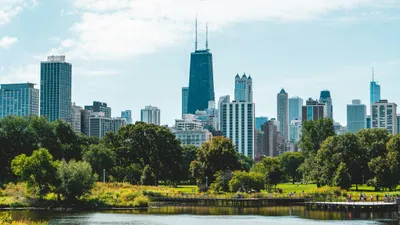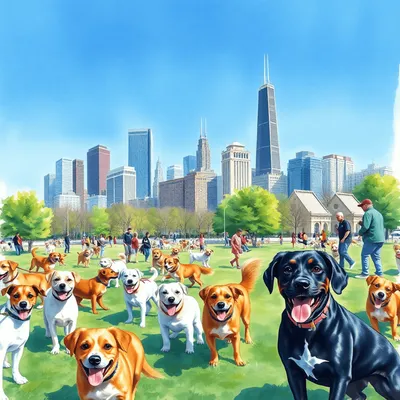Chicago—sprawling, relentless, swaggering Chicago—wears the nickname “Windy City” like a battered badge of honor, but the truth behind that moniker is as layered and contradictory as the city itself. Sure, there are gusts off Lake Michigan that’ll slap you across the face harder than a debt collector on payday, but to chalk it up to mere meteorology is to miss the real story—a tale soaked in political bluster, civic chest-thumping, and the kind of bare-knuckle rivalry that shaped America’s urban landscape in the late 1800s. This isn’t just about icy drafts howling between steel-and-glass towers; it’s about politicians whose mouths never stopped moving, each one desperate to outshout rivals and sell Chicago as the next great metropolis. The nickname isn’t just a casual nod to inclement weather—it’s an artifact of ambition, hot air, and pride so thick you could slice it with a rusty butcher’s knife.
The Windy Reputation of Chicago
Chicago’s so-called Windy City moniker isn’t just an old wives’ tale whispered among the locals. No, this beast of a town, huddled against the sprawling expanse of Lake Michigan, owes much of its blustery temperament to that very body of water. The lake, with its vast and unyielding presence, conjures up a distinct microclimate that whips the city’s streets into a frenzy. Come spring and summer, when the temperature tug-of-war between land and water is at its fiercest, these lake-born breezes become impossible to ignore, cutting through the urban jungle like a cold blade—sharp, relentless, and unapologetically omnipresent.
Chicago’s skyline isn’t just a monument to mankind’s insatiable appetite for steel and glass—it’s a goddamn wind factory, a hulking labyrinth where the air itself turns conniving. Those monolithic skyscrapers, standing shoulder to shoulder like bouncers outside an exclusive club, don’t just scrape the heavens—they funnel nature’s fury down to ground level. The so-called wind tunnel effect isn’t some polite meteorological quirk; it’s an urban gauntlet, an invisible boot in the ribs for anyone foolish enough to brave downtown on a blustery afternoon. You don’t just walk through the Loop when the wind is up; you stagger, you brace yourself, you curse the architects who unwittingly turned city blocks into wind-whipped corridors straight out of Dante’s fever dreams.
Key factors influencing Chicago’s windy reputation:
- Lake Michigan’s microclimate: Creates consistent breezes due to temperature differences between land and water.
- Urban architecture: Skyscrapers and narrow streets amplify wind speeds through the wind tunnel effect.
Understanding these elements helps explain why Chicago is often associated with strong winds, despite it not being the windiest city in the United States.
Historical Context of the “Windy City” Nickname
The Role of the 1893 World’s Columbian Exposition
The 1893 World’s Columbian Exposition didn’t just slap Chicago onto the world stage—it hammered its “Windy City” nickname into the American psyche with all the subtlety of a meat cleaver through bone. Billed as a four-hundred-year anniversary bash for Columbus’s misadventures, this sprawling spectacle drew hordes of gawkers, hustlers, and hopefuls into Chicago’s feverish embrace. The fair became a fever dream of architectural bravado and cultural mayhem, an audacious display that screamed to the world: pay attention or get left in the soot-choked dust. Journalists, those perennial vultures circling the scent of hype, seized on “Windy City”—not just for the city’s teeth-rattling gales off Lake Michigan, but also as a sly jab at the city’s overinflated ego and its politicians’ endless torrents of self-congratulatory bluster. The name stuck like grease to a diner’s griddle, forever entwining Chicago’s identity with both meteorological chaos and a talent for talking big.
Political Rivalry with Cincinnati
In the smoky, blood-and-sawdust arenas of late 19th-century America, Chicago locked horns with Cincinnati in a battle of egos that would shame the feuds of ancient Rome. The infamous moniker “Windy City” didn’t drift in on a gentle breeze—it was hurled like a brick through a tavern window during the virulent newspaper wars of the era. In 1876, with all the subtlety of a back-alley knife fight, the Cincinnati Enquirer spat out the term as an insult, accusing Chicagoans—reeling from yet another tornado—of being as full of bluster as their tempest-ravaged skies. The phrase stuck, not because it was true, but because it was sharp enough to draw blood. Thus, through political mud-slinging and journalistic bravado, “Windy City” became etched into the city’s battered psyche—less a nickname than a scar worn with something like pride.
Key Events:
- 1876: Cincinnati Enquirer references Chicago as “Windy City”
- 1893: World’s Columbian Exposition promotes Chicago’s image and nickname
This historical context reveals that the origins of “Windy City” are deeply intertwined with both meteorological phenomena and spirited civic rivalries.
Debunking Myths About Chicago’s Windiness
Let’s smash a myth: despite its blustery reputation, Chicago isn’t America’s windiest city. That title goes to places like Boston, where the wind would make even Midwesterners shiver. The data is clear—Chicago’s “Windy City” nickname stems more from political bluster than actual wind speeds.
1. Wind Speed Rankings
Forget what you’ve been spoon-fed about Chicago’s bluster—despite the city’s swaggering reputation, the National Weather Service and its bureaucratic cousins have crunched the numbers and handed down a cold, data-driven verdict: Chicago doesn’t even crack the top ten for average wind speeds among America’s heavyweight cities. Meanwhile, Boston, with its Puritan hangover and blue-blooded stoicism, stands at the front of the gale-force parade, reliably swaggering into one of those coveted top slots. So much for the mythos—sometimes, reality is even stranger than local legend.
2. Common Misconceptions
Visitors often step off the plane bracing for a relentless assault of wind, only to find that Chicago’s infamous gales are frequently outdone by those in coastal or plains cities. The question “Why is Chicago called the Windy City?” lingers like a stubborn aftertaste because the nickname hints at meteorological fury rather than the blustering political hot air it originally referenced.
“The Windy City” is a phrase rooted more in history and civic reputation than in consistent high winds.
Data-driven perspectives challenge long-held beliefs about Chicago’s climate. The myth lives on largely due to the power of branding and historical anecdotes rather than measurable meteorological phenomena.
Cultural Significance and Other Nicknames
Chicago’s identity sprawls far beyond the lazy moniker of the “Windy City.” This urban beast wears a multitude of masks, each nickname peeling back a different layer of its gritty soul, revealing the raw, pulsating heart beneath the steel and concrete façade:
1. Chi-town
This shorthand nickname, “Chi-town,” isn’t just a moniker; it’s a gritty badge of honor, dripping with an endearing, almost familial tone. Woven into the fabric of pop culture, sports, and music, “Chi-town” screams belonging and pride for those who call this tough city home. It crashes through lyrics, dominates headlines, and infiltrates conversations with the force of a freight train, embodying Chicago’s raw, unfiltered urban swagger.
2. City of Big Shoulders
Immortalized by the gritty verses of Carl Sandburg in his 1914 poem Chicago, this phrase grips the essence of the city’s blue-collar backbone and indomitable spirit. Sandburg painted Chicago as “Stormy, husky, brawling, / City of the Big Shoulders,” evoking the raw, muscular energy that hammered its railroads into existence and carved out its meatpacking empires. It’s a homage to Chicago’s working-class foundation and its relentless, almost feral ambition.
3. Second City
Frequently whispered in the darkened corridors of theater circles and far beyond, this nickname was birthed when Chicago clawed its way to becoming the second-largest city in the United States during the gritty dawn of the 20th century. The ascension of the “Second City” comedy troupe only sharpened its edge, transforming it from a badge of inferiority into a banner of relentless innovation and reinvention.
These nicknames are more than just catchy labels—they’re battle scars that define Chicago’s multifaceted identity: raw yet artistic, audacious yet grounded. Residents wear these terms like armor, because they encapsulate shared sagas—of rising from ashes, chiseling out cultural strongholds, and weaving together diverse communities under one defiant skyline.
Chicago’s Notable Features Beyond the Nickname
Chicago, the Windy City, is a sprawling metropolis that refuses to be defined by mere monikers. This beast of a city, with its shimmering skyscrapers piercing the heavens and its labyrinthine streets teeming with an eclectic mix of souls, is a living, breathing testament to American resilience. Forget about the breezes off Lake Michigan; it’s the relentless hustle, the raw grit of its blue-collar roots, that gives Chicago its true essence.
The city’s culinary scene is a battleground where chefs are gladiators, wielding their knives with ruthless precision. Here, deep-dish pizza isn’t just food—it’s a declaration of war against thin-crust purists. Each slice is a dense, decadent fortress of cheese and sauce that challenges both your appetite and your arteries. And then there’s the hot dog—dragged through the garden with more toppings than you can shake a celery salt shaker at—a defiant middle finger to simplicity.
But let’s not overlook Chicago’s architectural wonders. The skyline is a jagged crown of steel and glass, each building with its own story of ambition and audacity. The Willis Tower (forever Sears in the hearts of locals) stands as a sentinel over this urban jungle, while Frank Lloyd Wright’s Prairie-style homes whisper tales of innovation and rebellion against the mundane.
It’s in the neighborhoods where Chicago truly comes alive. From the bohemian vibes of Wicker Park to the historic grandeur of Hyde Park, each enclave pulses with its own unique rhythm. The streets are alive with murals that scream defiance and parks that offer brief respites from the concrete chaos.
And let’s not forget the people—tough as nails yet possessing an unyielding warmth. They carry on their shoulders the legacy of stockyards and steel mills, yet they also embrace change and diversity with open arms.
Chicago isn’t just a city; it’s an attitude—a gritty, unapologetic ode to survival and reinvention. So next time you find yourself caught in its gravitational pull, remember: it’s not just about surviving here; it’s about thriving amidst the chaos.
Chicago’s influence stretches far beyond its famous nickname.
Conclusion
Understanding Chicago’s identity is about more than just its “Windy City” moniker, a nickname that barely scratches the surface of this gritty, resilient metropolis. The term itself is steeped in a cocktail of political rivalries and urban legends that cling to the city’s bones like the relentless winds off Lake Michigan. But let’s not kid ourselves—Chicago’s pulse beats far beyond whimsical nicknames. This is the city that revolutionized the meatpacking industry, where blood and sweat mingled with ambition under cavernous slaughterhouse roofs. It’s the birthplace of iconic cuisine that’ll slap your taste buds awake faster than a cold gust down Michigan Avenue, and it’s a living museum of architectural wonders that defy gravity and convention alike.
When pondering why Chicago wears the “Windy City” badge, remember it’s an intricate blend of history, myth, and unabashed local pride that forges its soul. To truly grasp this city’s essence, you have to dive headfirst into all its facets—the good, the bad, and the unapologetically raw. Only then can you appreciate what makes Chicago not just a city, but a force of nature.

